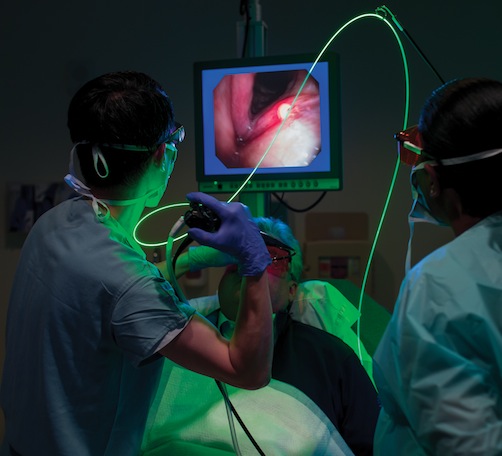Advanced Treatment for Recurrent Respiratory Papillomatosis
Recurrent respiratory papillomatosis (RRP) causes predominantly noncancerous (benign) tumors called papillomas (warts) to grow in the respiratory tract, which are the airways that connect the nose and mouth to the lungs. The papillomas most commonly develop in the larynx and can interfere with speaking, singing, or breathing.
The papillomas in RRP often grow back after removal because the virus can persist in tissue, so patients often require repeat treatment. If left untreated, papillomas can cause life-threatening breathing problems, recurrent pneumonia, and chronic lung disease. In very rare cases, the papillomas in RRP become cancerous.
Our expert, fellowship-trained laryngologists (ear, nose, and throat doctors with specialized training in disorders of the larynx) have extensive experience in treating people with RRP. We can often remove papillomas in the office with a minimally invasive laser treatment, avoiding the need for surgical procedures.
Cause of Recurrent Respiratory Papillomatosis
Two types of human papillomavirus (HPV) – HPV 6 and HPV 11 – cause RRP. More than 150 types of HPV exist, and they cause different symptoms and illnesses.
Not everyone who is exposed to HPV develops a related condition because the body can often fight off the virus on its own. In the small number of people who do develop an illness, respiratory tract papillomas and genital warts can grow. Scientists believe that HPV is likely spread through sexual contact or during childbirth in mothers who have genital warts.
Symptoms of Recurrent Respiratory Papillomatosis
As the papillomas grow, they can interfere with the normal vibrations of the vocal cords, causing symptoms such as:
Diagnosis of Recurrent Respiratory Papillomatosis
RRP symptoms are similar to those in a variety of other conditions, such as asthma, chronic bronchitis, or allergies. Our highly trained laryngologists have years of experience evaluating symptoms and ruling out other conditions to confirm a diagnosis of RRP. We begin with a thorough assessment, which includes a:
- Physical exam, with an inspection of the larynx and vocal cords
- Review of personal medical history
- Discussion of symptoms
To examine the vocal cords and larynx, we often use one or more instruments, such as a:
- Flexible laryngoscope: A narrow, flexible tube with a light and camera inserted through the nose
- Rigid laryngoscope: A narrow, rigid viewing tube inserted through the mouth
- Videostroboscope: A camera with a flashing light that provides a slow-motion view of the vocal cords as they vibrate
Additional tests we might order include a:
- Biopsy: Study of a small tissue sample taken during laryngoscopy
- Computed tomography (CT) scan: Specialized X-ray technology that takes cross-sectional images to produce 3D images of the chest to look for papillomas
Treatment for Recurrent Respiratory Papillomatosis
Treatment for RRP focuses on removing the papillomas because the disease itself currently has no cure. The goals of treatment are to:
- Keep the disease from spreading
- Maintain a safe airway
- Preserve nearby tissue
- Improve voice quality
Using the latest technology and minimally invasive techniques, our skilled surgeons carefully remove papillomas without damaging the larynx or vocal cords. We offer:
- In-office laser surgery using intense light frequencies to destroy papilloma tissue
- Microsurgery using lasers and microdebriders (miniature instruments that can shave away the papilloma with precision)
- Injections in the operating room using antiviral medications
In patients with severe disease, our laryngologists might recommend systemic medications to slow papilloma regrowth so that patients can go longer before needing repeat surgery. These medications include:
- Indole 3-carbinol
- Antiviral medications such as interferon
- Bevacizumab
Preventing Recurrent Respiratory Papillomatosis
The HPV vaccine can prevent the development of RRP. The Centers for Disease Control and Prevention (CDC) recommends that all children receive the HPV vaccine at age 11 to 12.





